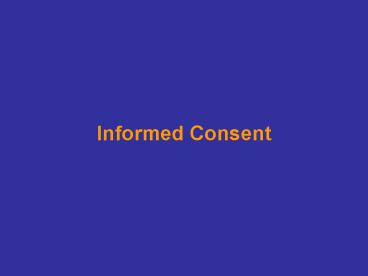Informed Consent - PowerPoint PPT Presentation
1 / 17
Title: Informed Consent
1
Informed Consent
2
As fiduciaries, optometrists owe an affirmative
duty of disclosure.To institute treatment,
consent must be obtained.Thus there is an
obligation to divulge certain information to a
patient and to receive an informed consent prior
to initiating treatment.
3
It has long been the law in the US that consent
is necessary before initiating medical
proceduresAny human being of adult years and
sound mind has a right to determine what shall be
done with his own body and a surgeon who
performs an operation without his patient's
consent commits an assault, for which he is
liable in damages.
4
There are rival legal rules that determine
informed consent on a state by state basis
- The professional community rule is the oldest
and requires a doctor to conform to the standard
of care expected of like doctors acting under the
same or similar circumstances. - The "reasonable patient" rule requires the scope
of disclosure to be determined by the patient's
need to know information that would be material
to his ability to make an informed decision.
5
Alabama is a reasonable patient rule state.In
general, disclosure to a patient must include
- the inherent and potential risks of the
procedure known risks of serious harm must be
disclosed, but minor risks of low incidence do
not a remote risk of death or serious bodily
harm also does not have to be disclosed
6
A patient was placed on oral acetazolamide (a
carbonic anhydrase inhibitor) for treatment of
bilateral glaucoma. No mention was made by the
doctor of the remote risk of contracting aplastic
anemia from the drug. After several weeks of
therapy, lab testing was performed because the
patient was experiencing bruising, and it was
discovered that she had aplastic anemia. Was this
failure to warn a violation of informed consent?
7
In general, disclosure to a patient must include
- alternative methods of treatment
8
A 15-year-old myopic patient who had read about
overnight contact lenses went to an
optometrist. He was fitted and began wear of the
lenses, but after about a month he suffered a
central corneal ulcer in one eye, secondary to
wear. Despite treatment, acuity in the eye was
significantly reduced. The optometrist never
discussed the option of daily wear lenses with
him. Does this omission constitute a breach of
informed consent requirements?
9
In general, disclosure to a patient must include
- abnormalities discovered during examination
10
A contact lens wearer complaining of blur and
gaps in her vision was examined, and IOPs were
found to be elevated. The doctor looked at the
optic nerves but decided not to perform visual
field testing. He did not inform the patient of
the elevated pressures. Two years later she was
diagnosed as having glaucoma, with significant
field loss. Did the failure to inform the patient
of the abnormal IOPs create a breach of informed
consent requirements?
11
The end result of communication with the patient
is to ensure that a truly informed consent is
obtained. Complicated procedures or terms must
be explained in lay language.If a patient asks
not to be informed, no disclosure is
required.The consent must be documented.
12
To successfully pursue an informed consent claim,
the patient must not only show that the doctor
did not meet disclosure requirements, but also
that an adequate disclosure would have resulted
in refusal to undergo the procedure.
13
In terms of the application of informed consent
to the clinical practice of optometry, the most
important concerns are
- dilation of the pupil when the anterior chamber
angle is narrow enough to cause an acute angle
closure - fitting a patient with extended (overnight) wear
contact lenses - failing to disclose a suspicious finding
- prescribing of therapeutic drugs with adverse
side effects without disclosure of the side
effects.
14
Informed consent is also necessary when
performing surgical procedures that pose a risk
of injury
- ocular foreign body removal
- punctal plug insertion
- curettage procedures (e.g., chalazion)
- ocular injections
15
Documentation of informed consent is often also
required for warnings of risk, such as for
diagnostic or therapeutic procedures (pupils
dilated or eyes patched) or clinical findings
(incomplete posterior vitreous detachment).Next
to negligence, informed consent arises most
frequently in the practice of optometry as a
cause of liability claims.
16
The most common mistake made by optometrists is
not failure to provide the necessary disclosure
it is failure to document that the disclosure was
given.The documentation must be sufficient to
describe why consent was necessary and that the
patients agreement was obtained.
17
(No Transcript)































